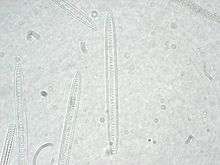Bacillaria
Bacillaria is a diatom genus in the family Bacillariaceae.[1][2][3]
| Bacillaria | |
|---|---|
 | |
| Bacillaria paxillifer | |
| Scientific classification | |
| Kingdom: | Chromista |
| Phylum: | Ochrophyta |
| Class: | Bacillariophyceae |
| Order: | Bacillariales |
| Family: | Bacillariaceae |
| Genus: | Bacillaria J.F. Gmelin (1791) |
Species
- Bacillaria paradoxa Gmelin 1788
- Bacillaria paxillifer (O.F. Müller) Hendey (1951)
Lifecycle
This genus is photosynthetic, and reproduces sexually and asexually.
Description
Cells are elongated and motile, sliding along each other, in stacked colonies. Cells are rectangular in girdle view (when in colonies), and lanceolate in valve view. Raphe system is slightly keeled and runs from pole to pole. Two large plate-like chloroplasts are present, one near each end of the cell. The nucleus is located centrally. Cells are yellow-brown in colour. Fibulae are strong, and the valve surface is covered in transverse parallel structures called striae.
Measurements
Length (apical axis[4]): 70 - 200 μm
Width (trans-apical axis)[5]: 5 - 8 μm
Height (Pervalvar axis)[6]: 5 - 10 μm
Fibulae: 7 - 9 in 10 μm
Striae: 20 - 21 in 10 μm
Habitat
Benthic zone, marine and brackish/freshwater species, but is also commonly found in plankton.
References
- "ITIS Standard Report Page: Bacillaria". www.itis.gov. Retrieved 20 April 2018.
- M.G. Kelly; H. Bennion; E.J. Cox; B. Goldsmith; J. Jamieson; S. Juggins D.G. Mann; R.J. Telford (2005). "Common freshwater diatoms of Britain and Ireland: an interactive key". Environment Agency, Bristol. Archived from the original on 2012-04-25. Retrieved 2011-12-21.
- "Algaebase".
- "Apical axis | Glossary - Diatoms of North America".
- "Transapical axis | Glossary - Diatoms of North America".
- "Pervalvar axis | Glossary - Diatoms of North America".
- "EOS - Phytoplankton Encyclopedia Project". www.eoas.ubc.ca. Retrieved 2017-02-04. Phytoplankton Encyclopedia Project